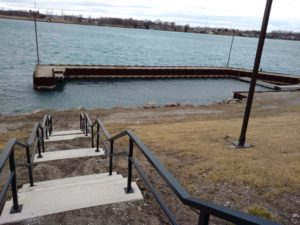Aamjiwnaang First Nation to reconnect to one of the Great Lakes’ major channels

By Colin Graf
AAMJIWNAANG FIRST NATION—After decades of anxiety about the health of their ancestral water source, the people of the Aamjiwnaang First Nation are renewing their ties with one of the Great Lakes’ major connecting channels, the St. Clair River.
As chemical spills from Sarnia’s Chemical Valley adjacent to Aamjiwnaang decline, plans are underway to promote fishing and even swimming in the once-feared waters. Organizers hope to entice people, along with wildlife, back to the river by “softening” the shoreline, according to Sharilyn Johnston, head of the community’s environment department. Replacing the sheet metal pilings that mark the water’s edge with two tiers of stone, grass, and aquatic plants will naturalize the river bank, making access easier and more pleasant for people. It will also provide a natural route for wildlife such as mink to come to the river to fish, she says.
A planned groyne extending into the river will also improve habitat for fish in the river, as they rest or spawn in eddies the pier will create. A walkway on the groyne will help get people back onto the water for fishing or relaxation, Johnston explained, during Aamjiwnaang’s St. Clair River Day, on Feb. 25.
Around 25 metres of shoreline will be improved, at a cost of $72,475.00. The work is being paid for by the Goderich Port Management Corporation as compensation for an extension to the Goderich harbour. The funding results from Fisheries and Oceans Canada requiring developers to make up for any reduction in fish habitat their work may cause, according to Johnston. The work should start late this year and be finished early in 2018.
Future projects could include a new fishing pier that would create fish habitat underneath, and a swimming platform that would float on the river, Johnston said.
Large reductions have been made in both industrial spills and human waste entering the river, said Donna Strang, coordinator of the Remedial Action Plan for the St. Clair River, during the River Day presentations. While annual chemical spills could top 100 during the late 1980s and early 90s, fewer than 20/year has become the norm, according to data provided by Strang. Compared to past decades when persistent oil slicks could be seen “frequently” on the river, things are much better, she said.
Information for adults at the event was combined with fun activities for children to help them understand the challenges of restoring health to the St. Clair. At one event, Aamjiwnaang citizen and mother Shawna Riley watched her children sort and eat multi-coloured Goldfish crackers to represent how often they can safely eat different fish species. She says her family will eat fish caught from the river, but not often as fears of pollution still linger, despite the river being less polluted.
“It’s still in your mind…to worry about what you’re eating,” noted Riley. “Hopefully that will change in [my children’s] time.”
Another popular activity related to a different problem along the river included having the children walk a ‘pretend’ Canada goose across their beach paintings and watch it drop green stars to represent feces that would spoil their time at the beach.
Aamjiwnaang Chief Joanne Rogers sees more people coming back to the river, though the community has never abandoned their relationship with the water.
“We’ve always fished and we still swim…but some people stopped swimming years ago because of pollution,” stated Chief Rogers. “There are definitely fewer [chemical] releases now, but what will really turn this around is the way our Environment Department is watching industry and making sure our water is protected.”


